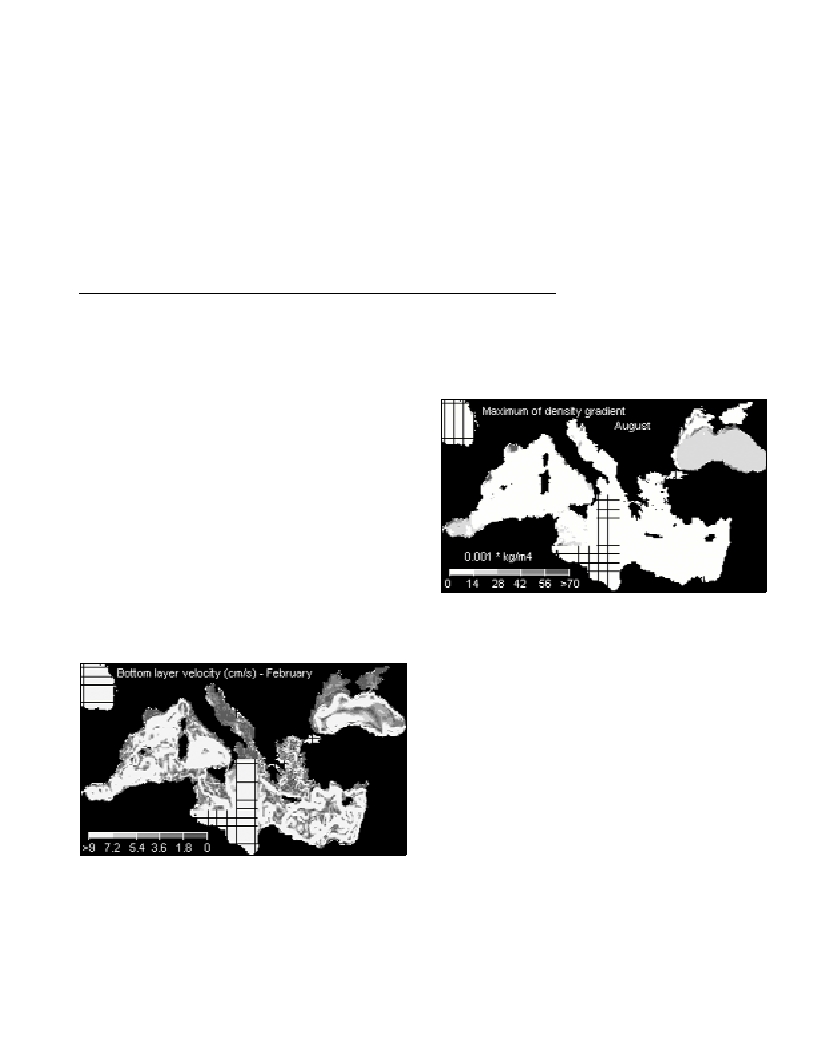Rapp. Comm. int. Mer Médit., 37,2004
94
RELATIVE CONTRIBUTION OF EUTROPHICATION AND HYDROMORPHOLOGY TO BOTTOM OXYGEN
DEFICIENCY: THE CASE OF THE MEDITERRANEAN AND BLACK SEAS
Jean-Noël Druon
(1)*
, Wolfram Schrimpf
(1)
, Srdjan Dobricic
(1)
, Elisaveta Peneva
(1)
, Alex Lascaratos
(2)
,
Sarantis Sofianos
(2)
, Pierre Garreau
(3)
, Samuel Djavidnia
(1)
(1)
European Commission-Joint Research Centre, Institute for Environment & Sustainability, Inland & Marine Waters Unit,
TP 272, I-21020 Ispra (VA) - Italy - * jean-noel.druon@jrc.it
(2)
University of Athens, Ocean Physics and Modelling Group University Campus, Building PHYS-V, 15784, Athens, Greece
(3)
IFREMER – Center of Brest, DEL/AO, BP 70, 29280 Plouzané, France
Abstract
As hydromorphology plays a key role in isolating bottom waters from vertical and horizontal supply of oxygen, its contribution to bottom
oxygen deficiency is discussed relatively to eutrophication (oxygen sink). If nutrient over-enrichment of margins is largely responsible of
cultural eutrophication and seasonal hypoxia or anoxia (northern Adriatic Sea and north-west Black Sea), permanent stratification leads to
anoxia rather independently of the trophic conditions (deep Black Sea). In case climatic changes favour a decrease of the hydrodynamics,
and particularly when stratification is reinforced in its extension or duration, the contribution of hydrology to bottom oxygen deficiency
would significantly increase.
Keywords: oxygen deficiency, hydromorphology, eutrophication, Mediterranean Sea, Black Sea
Eutrophication is defined [1] as ‘an increase in the rate of supply of
organic matter to an ecosystem’. Besides this main direct effect and
the causative factors, e.g. nutrient enrichment, a holistic assessment of
eutrophication should include the supporting environmental factors,
e.g. hydromorphological conditions, and the indirect effects, e.g.
oxygen deficiencies or changes in benthic community structure. We
propose here to investigate the in?uence of bathymetry and hydrology
on bottom oxygen deficiency in the Mediterranean and Black Seas.
The monthly mean data is extracted from 3D physical models based
on climatology (or a mean of several years).
Bottom hypoxia is mainly controlled by the load of particulate
organic matter (POM) that reaches the bottom and the physical
capacity of the system to renew the near bottom oxygen [2].
These enclosed seas are mostly characterized by an important water
column in which the POM degradation mainly occurs. However, in
two important continental shelves, i.e. the northern Adriatic Sea and
the north-west Black Sea, a significant fraction of the POM fuelled by
the Po and Danube rivers reaches the sea bottom of the continental
shelf. In both cases, poor hydrodynamical conditions limits the
vertical (mixing) and horizontal (transport) oxygen supply to the
bottom waters leading to seasonal hypoxia/anoxia. The summer
stratification favours in these areas the primary production as nutrient
and light are available near the surface. The stratification, together
with low bottom friction (not shown), isolates bottom waters from the
vertical supply of oxygen. The low advection near the sea bed (Fig.1)
contributes in reducing the horizontal supply of oxygen.
Fig. 1. Mean bottom advection of the benthic layer (cms
-1
) for August in
the Mediterranean and Black Seas. Dark colours represent unfavourable
conditions as regards to oxygen deficiency. Striped areas are regions not
covered by the models.
The gathering of these unfavourable hydromorphological
conditions in both continental margins of the Adriatic and Black Seas
increases the effect of nutrient over-enrichment leading to seasonal
oxygen deficiencies. In areas where the margin extension is small, the
eutrophication-induced risk of hypoxia is limited in case the
stratification is seasonal. The permanent halocline encountered in the
Black Sea (Fig.2) increases tremendously the physical sensitivity to
oxygen deficiency. The bottom waters are permanently isolated and
the oxygen bulk is consumed progressively even when the surface
productivity is relatively low. It is thus suggested that the deep
Mediterranean Sea is protected from oxygen deficiency by the
absence of permanent stratification.
Fig.2. Mean stratification intensity (kgm
-4
) for February in the
Mediterranean and Black Seas. Dark colours represent unfavourable
conditions as regards to oxygen deficiency. Striped areas are regions not
covered by the models.
Beside the nutrient loads from rivers, the impact of eutrophication
is therefore largely controlled by the morphology of the receiving
coastal area (semi-enclosed or open and water depth) and the regional
hydrology (stratification, bottom friction, transport). In case of
permanent stratification, anoxia can occur rather independently of the
trophic condition. It is concluded that climatic changes which would
lead to a decrease of the hydrodynamics, and particularly those which
would reinforce the stratification either seasonally or permanently,
would increase the sensitivity to bottom hypoxia and alter
consequently the ecosystem functioning.
References
[1]Nixon S.W. (1995) Coastal marine eutrophication: A definition, social
causes, and future concerns. Ophelia,41: 199-219.
[2]Druon J.N., Schrimpf W., Dobricic S., Stips A. (submitted)
Comparative assessment of large scale marine eutrophication: North Sea
area and Adriatic Sea as case studies, Mar. Ecol. Prog. Series.

